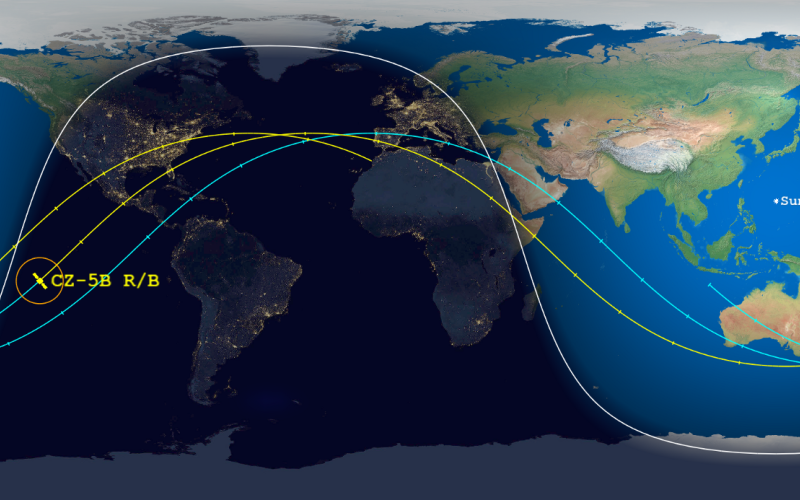The Aerospace Corporation recently published the following interview with Marlon Sorge of Aerospace's Center for Orbital and Reentry Debris Studies (CORDS) on Medium.
UPDATE:
Official update from @US_SpaceCom with time/place of #LongMarch5B reentry. https://t.co/0rFWhZjekD
— The Aerospace Corporation (@AerospaceCorp) May 9, 2021
ORIGINAL POST:
A large Chinese rocket stage is expected to reenter Earth’s atmosphere in the coming days and experts are concerned about the potential impact of the debris.
The Long March 5B successfully launched a 22.5-metric-ton core module of China’s first space station last week. During the launch, the first stage of the Long March 5B also reached orbital velocity instead of falling downrange as is common practice. That placed the empty rocket body in an elliptical orbit around Earth where it is being dragged toward an uncontrolled reentry in the coming days.

The rocket stage’s orbital inclination of 41.5 degrees means that reentry can be as far north as Chicago, New York City, Rome and Beijing and as south as New Zealand and Chile. That places any of those locations within the potential reentry path of this giant piece of space junk measuring 98 feet long and 16.5 feet wide and weighs 21 metric tons.
The Center for Orbital and Reentry Debris Studies (CORDS) at The Aerospace Corporation is tracking the Long March 5B reentry. We spoke with Marlon Sorge, CORDS principal engineer about how the situation developed and what happens next.
How often does an uncontrolled reentry of this size occur? Have there been other instances that compare?
Sorge: This stage and its predecessor last May are the sixth and seventh largest objects to ever reenter. The mass of this core stage is 21 metric tons.
The list of other comparably-sized objects that have reentered includes early space stations — like Mir, Skylab, Salyut 6 and 7 — and the Saturn V second stage that launched Skylab. These represent a mix of controlled and uncontrolled reentries, however.
What normally happens with a rocket stage like this and what was different this time?
Sorge: Normally the first stage of a rocket and its strap-on boosters are not designed to reach orbit. Their trajectories are planned so that the stage and any strap-on boosters fall into a safe area, usually in the ocean. In this case the first stage core of the rocket reached orbit. That means that it was no longer able to control where it would reenter without a deorbit maneuver.
What is a “deorbit maneuver”? Could that have been attempted?
Sorge: A deorbit maneuver uses a satellite or rocket stage’s engines to drop the low point of its orbit to choose where it hits the earth. This is called a controlled reentry. By doing this a large object can be targeted for an unpopulated region of the ocean where its debris will not injure anyone. The ability to conduct a deorbit maneuver is dependent on the design of the vehicle and the mission. It is not uncommon for rocket operators to plan for deorbit maneuvers and controlled reentries as large rocket stages tend to pose larger risks to people on the ground.
How much of the Long March 5B rocket stage is expected to survive reentry and reach the Earth’s surface?
Sorge: The general rule of thumb is that 20–40% of the mass of a large object will reach the ground, but the exact number depends on the design of the object. In this case, we would expect about five to ten metric tons. Generally, for an upper stage, we see small and medium tanks survive more or less intact, and large engine components. The large tanks and the skin of this core stage are likely to come apart. We will also see lightweight material such as insulation fall out. The melting point of the materials used will make a difference in what remains. You can learn more here.
How likely is it that I will get struck by space debris from this reentry? As of right now, do we know where the debris is likely to land?
Sorge: The probability that any random reentry will land in the ocean is about 3:4, since the Earth is about 75% covered by oceans. Also, the majority of the land mass is either uninhabited or lightly inhabited: deserts, mountains, forests, and open prairie, farms, or grasslands. The probability that a piece of space debris will land on a city or a densely populated area is usually relatively small. What makes this reentry particularly noteworthy is that it will occur between 41.5 deg N and 41.5 deg S latitudes, where the vast bulk of the world’s population lives.
However, the statistical risk to any one person of being struck by falling space debris is so low that a colleague of mine jokes that if reentry predictions put his house directly under the path, he’d go out with a camera and watch.
Read more about what those yellow and blue lines mean.
What can the space industry be doing to avoid these types of uncontrolled reentries from happening in the future?
Sorge: There are established methods for analyzing the reentry breakup of any object we launch into space and determining the casualty risk to people on the ground. If the risk exceeds a threshold, one should mitigate the risk by either altering the design or changing the reentry. For rocket stages, this usually means planning a controlled reentry into a broad, open area such as an ocean — the southern Pacific is a common target. Controlled reentries, particularly for a large object, require considerable planning and will have a significant impact on the design and payload capacity of the stage. Nevertheless, this is a preferred approach in international standards and is rapidly becoming a global norm.
You can track the Long March 5b here.

